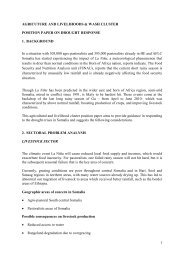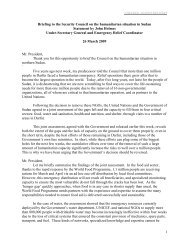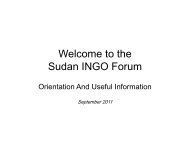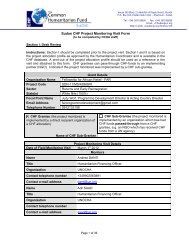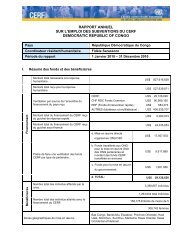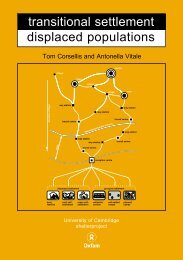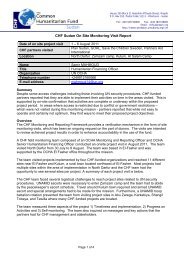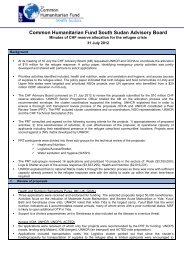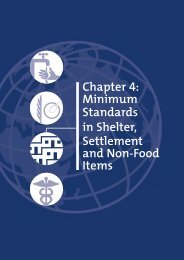Ethiopia - OCHANet
Ethiopia - OCHANet
Ethiopia - OCHANet
Create successful ePaper yourself
Turn your PDF publications into a flip-book with our unique Google optimized e-Paper software.
145. The apparent lack of trust between government and its NGO partners in particular is a significant<br />
impediment to the national response system. The federal government criticises NGO fundraising<br />
methods and their overhead costs (including their perceived reliance on expatriate employees)<br />
and is slow to approve the start up of new programmes. NGOs in turn are reluctant to take risks or to<br />
proceed without all the necessary permissions. This results in criticism of the NGOs for slow response.<br />
146. NGOs constitute, together with the big UN agencies such as WFP and UNICEF, a significant<br />
resource for the government in implementing their development agenda, and in providing<br />
capacity to respond fast to disasters. A more creative solution needs to be found by the <strong>Ethiopia</strong>n<br />
Government if it wishes to properly use this resource. A pre-qualification process, similar to that<br />
used by ECHO and USAID and being put in place currently by DFID, might be one solution.<br />
This would allow the best performing NGOs to respond ahead of official declarations – perhaps<br />
even obliging pre-qualified partners to go to new areas as required, and might also allow for<br />
Innovative pre-financing type arrangements to be put in place.<br />
147. Information sharing is also a significant barrier to response and to partnership. While there<br />
is ample information available from a multitude of sources within the country, the federal government<br />
is reluctant to disseminate it widely, often for historical and cultural reasons. This breeds<br />
a similar reluctance on the part of partners. The failure to agree on data for dissemination<br />
is a significant brake on effective and early action.<br />
148. Whilst the general response coordination system is well evolved, if complex and sometimes<br />
overly bureaucratic, the refugee coordination approach in <strong>Ethiopia</strong> has clear faults. As already highlighted<br />
above the care and maintenance partnership between the UNHCR and ARRA is effective<br />
and well-tested. That for a major refugee response has weaknesses, unclear divisions of labour<br />
and accountability and is in need of an early review if the resources available to the Government<br />
of <strong>Ethiopia</strong> and UNHCR are to be maximised.<br />
149. Although the international system for non-refugee coordination has evolved since 2005 such<br />
that other agencies are familiar with the “new rules” of cluster, this was not the case for this acute<br />
refugee emergency. Eventually an “accountability matrix” was developed, allocating roles to agencies<br />
by sector and by camp, but arguably valuable time was lost in this exercise. One clear lesson<br />
from Dolo Ado is that UNHCR now has to refine its global agreements with UNICEF and some of the<br />
main NGOs so that it can rapidly mobilise additional capacity.<br />
Conclusions<br />
1. Coordination of humanitarian activities in <strong>Ethiopia</strong> is highly evolved, meaning the cluster<br />
system has not established itself in the way it has in other contexts.<br />
2. The introduction of a new Disaster Risk Management Policy – in process since 2009 – has<br />
meant that the ‘system’ is in partial limbo. Decentralisation is already happening de facto,<br />
but without all of the structures and powers envisaged in the new DRM policy.<br />
3. The introduction of the strategic and technical multi-agency coordination groups<br />
was a worth while innovation and should be continued.<br />
4. The Humanitarian Coordination function, assisted by OCHA and OCHA field presence, plays<br />
44




